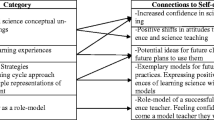Abstract
Self-efficacy has been shown to be an issue of concern for primary teacher education students – many of them have low self-efficacy and this can negatively affect their future teaching of science. Previous research has identified four factors that may contribute towards self-efficacy: enactive mastery experiences, vicarious experiences, verbal persuasion and physiological/affective states. It could also be argued that there are additional sources of self-efficacy that apply to primary teacher education students, namely cognitive content mastery, cognitive pedagogical mastery and simulated modelling. The main purpose of the present paper was to investigate the relative importance of the various sources of self-efficacy in a primary science methods course. Data on changes in self-efficacy and sources of self-efficacy were collected throughout the course using formal and informal surveys. It was found that the main source of self-efficacy was cognitive pedagogical mastery.
Similar content being viewed by others
References
Appleton, K. (1995). Student teachers’ confidence to teach science: Is more science knowledge necessary to improve self-confidence? International Journal of Science Education, 17, 357–369.
Appleton, K., & Kindt, I. (1999). Why teach primary science? Influences on beginning teachers’ practices. International Journal of Science Education, 21, 155–168.
Appleton, K., & Kindt, I. (2002). Beginning elementary teachers’ development as teachers of science. Journal of Science Teacher Education, 13, 43–61.
Bandura, A. (1982). Self-efficacy mechanism in human agency. American Psychologist, 37, 122–147.
Bandura, A. (1997). Self-efficacy: The exercise of control. NY: W.H. Freeman and Co.
Bell, G. L. (2001, March). Reflective journal writing in an inquiry-based science course for elementary preservice teachers. Paper presented at the Annual Meeting of the National Association for Research in Science Teaching, St. Louis, MO.
Cannon, J. R., & Scharmann, L. C. (1996). Influence of a cooperative early field experience on preservice elementary teachers’ science self-efficacy. Science Education, 80, 419–436.
Cantrell, P., Young, S., & Moore, A. (2003). Factors affecting science teaching efficacy of preservice elementary teachers. Journal of Science Teacher Education, 14, 177–192.
Enochs, L. G., & Riggs, I. M. (1990). Further development of an elementary science teaching efficacy belief instrument: A preservice elementary scale. School Science and Mathematics, 90, 695–706.
Ginns, I. S., Watters, J. J., Tulip, D. F., & Lucas, K. B. (1995). Changes in preservice elementary teachers’ sense of efficacy in teaching science. School Science and Mathematics, 95, 394–400.
Jarrett, O. S. (1999). Science interest and confidence among preservice elementary teachers. Journal of Elementary Science Education, 11, 47–57.
Morrisey, J. T. (1981). An analysis of studies on changing the attitude of elementary student teachers toward science and science teaching. Science Education, 65, 157–177.
Mulholland, J., & Wallace, J. (1996). Breaking the cycle: Preparing elementary teachers to teach science. Journal of Elementary Science Education, 8, 17–38.
Mulholland, J., & Wallace, J. (2001). Teacher induction and elementary science teaching: Enhancing self-efficacy. Teaching and Teacher Education, 17, 243–261.
Posnanski, T. J. (2002). Professional development programs for elementary science teachers: An analysis of teacher self-efficacy beliefs and a professional development model. Journal of Science Teacher Education, 13, 189–220.
Rice, D. C., & Roychoudhury, A. (2003). Preparing more confident preservice elementary science teachers: One elementary science methods teacher’s self-study. Journal of Science Teacher Education, 14, 97–126.
Schoon, K. J., & Boone, W. J. (1998). Self-efficacy and alternative conceptions of science of preservice elementary teachers. Science Education, 82, 553–568.
Settlage, J. (2000). Understanding the learning cycle: Influences on abilities to embrace the approach by preservice elementary school teachers. Science Education, 84, 43–50.
Tosun, T. (2000). The beliefs of preservice elementary teachers towards science and science teaching. School Science and Mathematics, 100, 374–379.
Watters, J. J., & Ginns, I. S. (2000). Developing motivation to teach elementary science: Effect of collaborative and authentic learning practices in preservice education. Journal of Science Teacher Education, 11, 301–321.
Wingfield, M. E., Freeman, L., & Ramsey, J. (2000, April–May). Science teaching self-efficacy of first year elementary teachers trained in a site based program. Paper presented at the Annual Meeting of the National Association for Research in Science Teaching, New Orleans, LA.
Author information
Authors and Affiliations
Corresponding author
Rights and permissions
About this article
Cite this article
Palmer, D.H. Sources of Self-efficacy in a Science Methods Course for Primary Teacher Education Students. Res Sci Educ 36, 337–353 (2006). https://doi.org/10.1007/s11165-005-9007-0
Published:
Issue Date:
DOI: https://doi.org/10.1007/s11165-005-9007-0




